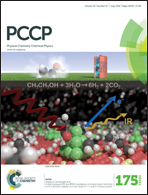Structural and relative energy assessments of DFT functionals and the MP2 method to describe the gas phase methylation of nitronates: [R1R2CNO2]− + CH3I†
Abstract
The performances of 26 combinations of density-functional theory (DFT) functionals or second-order Møller–Plesset (MP2) methods and basis sets were evaluated for the calculation of the activation energy (Δ‡E), the energy available (ΔRCE) to the reactant complex, the energy of reaction (ΔrE), and rotational constants of the main structures involved in the methylation reactions of nitronates, [R1R2CNO2]− + CH3I, in the gas phase, where R1 = R2 = H, R1 = H and R2 = CH3, R1 = R2 = CH3, and R1 + R2 = c-(CH2)2. The separated reactants and products, the reactant and product complexes, and the transition states were considered, leading to 43 data points for the statistical analysis for each method under assessment. Five statistical quantifiers: the mean signed error (MSE), the mean unsigned error (MUE), the percent mean relative error (% MRE), best and worse (BW), and the confidence interval (CI) were used to assess the performance of methods relative to the CCSD(T)/CBS//MP2/aug-cc-pVTZ reference method. The DFT functionals included the widely applied B3LYP and M06-2X global-hybrids and the recently available DSD-PBEP86, DSD-PBEP86-D3BJ and PWPB95 double-hybrids. The basis sets involved an effective core potential (ECP) for describing the inner electrons of iodine such as LANL2DZdp and aug-cc-pVXZ-PP (X = D, T, and Q), and all-electron basis sets for the remaining atoms. The energy available to the reactant complex is described quite well by all methods, however, only the MP2/aug-cc-pVTZ-PP method provided values within 2 kcal mol−1 (8.4 kJ mol−1) from the reference method for Δ‡E and ΔrE. Amongst the DFT methods, the global-hybrid M06-2X functional produced the best overall results including BW and CI. Notice that all methods yielded the smallest Δ‡E for the C-methylation pathway. The rotational constants of the reactant complexes and the transition state structures were compared, for which the MP2 method and the M06-2X functional provided the most accurate results. Thus, unlike previous assessments of DFT functionals for describing SN2 reactions, M06-2X was the most accurate for these methylation reactions of nitronates, followed closely by the DSD-PBEP86 double-hybrid functional. The inclusion of dispersion effects with DSD-PBEP86-D3BJ does not improve the accuracy. Whereas MP2/aug-cc-pVTZ was the most accurate and nearly provided results with chemical accuracy.
![Graphical abstract: Structural and relative energy assessments of DFT functionals and the MP2 method to describe the gas phase methylation of nitronates: [R1R2CNO2]− + CH3I](/en/Image/Get?imageInfo.ImageType=GA&imageInfo.ImageIdentifier.ManuscriptID=C5CP07833D&imageInfo.ImageIdentifier.Year=2016)

 Please wait while we load your content...
Please wait while we load your content...